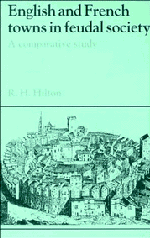2 - The feudal presence in towns
Published online by Cambridge University Press: 03 May 2011
Summary
TOWNS IN THE TRANSITION FROM ANCIENT TO FEUDAL SOCIETY
One of several problems facing a historian attempting to interpret urban social and economic structures in terms of the feudal social formation within which they were located, is that of the chronology of feudalism. The problem cannot be ignored when more and more evidence is appearing that the de-urbanisation of post-Roman society (say from the fifth century onwards) has been exaggerated – partly because of the emphasis which has been put on the urban expansion of the eleventh century. What was the social formation which followed the collapse of the ancient world? It certainly was not the ‘fief–vassal’ aspect of feudalism which developed from the tenth century onwards. But if the broader definition of feudalism is accepted, as primarily a social formation determined by the exploitation of a dependent peasantry by a ruling class of landowners – far removed both from a ‘slave mode of production’ (if ever predominant) and from the tax-gathering Roman imperial state – then we may find its early manifestations at least by the sixth century, though as shown in chapter 1, there are some difficulties in defining the social formation of the early Frankish and Anglo-Saxon kingdoms.
- Type
- Chapter
- Information
- English and French Towns in Feudal SocietyA Comparative Study, pp. 25 - 52Publisher: Cambridge University PressPrint publication year: 1992

